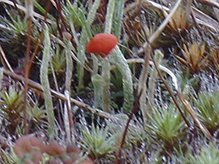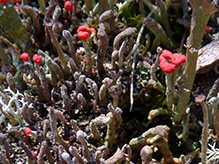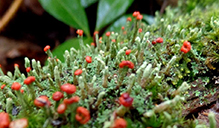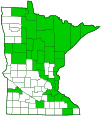Lipstick Powderhorn
(Cladonia macilenta)
Conservation • Description • Ecology • Distribution • Taxonomy
Conservation Status |
|
|||||||
| IUCN Red List | not listed |
|||||||
| NatureServe | NNR - Unranked |
|||||||
| Minnesota | not listed |
|||||||
Description |
||
Lipstick Powderhorn is a widespread and very common lichen. It has a worldwide distribution that includes every continent except Antarctica. It occurs across North America but is most common east of the Great Plains and on the West Coast. It is common in Minnesota. It grows on dead wood and often at the bases of trees. It sometimes grows on bare ground or on rock. Lipstick Powderhorn produces two types of vegetative growth (thallus). The primary thallus is composed entirely of flat, overlapping, leaf-like scales (squamules) that adhere closely to the substrate. Each of these basal squamules is 1 ⁄32″ to ¼″ (1 to 6 mm) long and 1 ⁄16″ to 3 ⁄16″ (2 to 5 mm) wide. They are sometimes covered with tiny granules (soredia). The secondary thallus is a slender vertical stalk (podetium) that rises from the center of a basal squamule. The podetia is grayish-green to whitish-green, hollow, more or less curved, unbranched or sparingly unbranched, ⅜″ to 13 ⁄16″ (10 to 30 mm) tall, and 1 ⁄32″ to ⅛″ (1 to 4 mm) wide. The layer of protective tissue (cortex) is thick at the base, disappears in the upper portions, and is thick below the reproductive structure (apothecium). The podetia is mealy due to a covering of soredia. The apothecia appear as a bright red, 1 ⁄64″ to ⅛″ (.05 to 3 mm) wide tip to many but not all of the podetia. |
||
Similar Species |
||
British Soldier Lichen (Cladonia cristatella) is more branched at the tip. |
||
Ecology |
||
Substrate |
||
Ground |
||
Growth Form |
||
Fruticose |
||
Habitat |
||
|
||
Hosts |
||
|
||
Distribution |
||||
|
||||
| 10/11/2023 | ||||
Occurrence |
||||
Widespread and very common |
||||
Taxonomy |
|||
| Kingdom | Fungi (fungi including lichens) | ||
| Subkingdom | Dikarya | ||
| Phylum | Ascomycota (sac fungi) | ||
| Subphylum | Pezizomycotina (sac fungi amd lichens) | ||
| Class | Lecanoromycetes (common lichens) | ||
| Subclass | Lecanoromycetidae (shield lichens, sunburst lichens, rosette lichens, and allies) | ||
Order |
Lecanorales (shield lichens, rim lichens, and allies) | ||
Suborder |
Lecanorineae | ||
Family |
Cladoniaceae (spindles and structured lichens) | ||
Genus |
Cladonia (pixie cup and reindeer lichens) | ||
| Mycobiont | Cladonia macilenta | ||
| Photobiont | |||
Synonyms |
|||
|
|||
Common Names |
|||
Lipstick Powderhorn Lipstick Powderhorn Lichen |
|||
Glossary
Apothecium
An open, disk-shaped or cup-shaped, reproductive structure, with spore sacs on the upper surface, that produces spores for the fungal partner of a lichen. Plural: apothecia.
Soredium
An asexual reproductive structure of a lichen in the form of a tiny dull granule on the thallus surface that can be easily brushed off. It consists of a cluster of algal cells (the photobiont) wrapped in fungal filaments (the mycobiont), but without an outer layer of protective tissue (cortex). Plural: soredia.
Thallus
The vegetative body of a lichen composed of both the alga and the fungus.
Visitor Photos |
|||||
Share your photo of this fungus. |
|||||
| This button not working for you? Simply email us at info@MinnesotaSeasons.com. Attach one or more photos and, if you like, a caption. |
|||||
Luciearl |
|||||
 |
 |
||||
 |
|||||
MinnesotaSeasons.com Photos |
|||||
|
|||||

Slideshows |
||

Visitor Videos |
|||
Share your video of this fungus. |
|||
| This button not working for you? Simply email us at info@MinnesotaSeasons.com. Attach a video, a YouTube link, or a cloud storage link. |
|||
Other Videos |
|||
| Cladonia macilenta en el Monte San Lois (Noia). Ría de Noia. Ría de Noia |
|||
About
Published on Sep 10, 2017 La cladonia macilenta es un liquen poco común en la zona de la Ría de Noia, se puede encontrar en suelos minerales pobres, turberas, madera en descomposición o en las bases de los árboles mas viejos, en lugares abiertos o en bosque cerrado. Google Translation: The cladonia macilenta is a rare lichen in the area of the Ria de Noia, it can be found in poor mineral soils, peat bogs, decomposing wood or in the bases of older trees, in open places or in closed forest. |
|||


Created: 8/18/2019
Last Updated:



